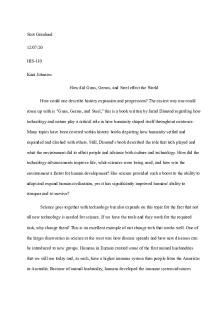Week One - Guns Germs and Steel - Questions for the reading and video (Repaired) PDF

| Title | Week One - Guns Germs and Steel - Questions for the reading and video (Repaired) |
|---|---|
| Author | Yehuda Smilovici |
| Course | Voices Without Borders: Global Chorus |
| Institution | Ryerson University |
| Pages | 2 |
| File Size | 81.8 KB |
| File Type | |
| Total Downloads | 21 |
| Total Views | 128 |
Summary
first week completed homework...
Description
Guns Germs and Steel: Questions for the reading and video The section of the documentary that we are concerned with can be found at: https://www.youtube.com/watch?v=i885hopsw6E
1. What is the main question the book is trying to answer? Why did history unfold differently on different continents?
2. What technological development happened in certain areas in the world around 10,000 BCE? The technology that immersed during this time period (between the hunter-gatherer period and the agricultural period) was the ability to plan out what food they would be able to eat, while adapting to the climate change. Another major advancement during this time was the production of tools and weapons. These weapons and tools were used in order to help them with hunting, as well as altercations between other civilizations.
3. Which four areas did this happen in? Certain parts of Europe, Middle East, Asia, and certain parts of Africa
4. What did this allow people to do in these areas? Rather than travelling far to hunt the animals that were the safest option, these tools allowed them to hunt almost all animals in their vicinity, these tools also helped them choose which plants were the most efficient making food more accessible all year round. 5. In 7000 BCE another technological development occurred – what was it? During this time, they went from a lifestyle of primarily hunting and gathering, to farming and agriculture. A tool they used during this time was the domestication of plants and animals. This time period was called the Neolithic Revolution. 6. Which area derived the greatest benefit from these technologies, and why? The fertile crescent derived the greatest benefit from these technologies because of it’s warm climate, easy cultivation of the land, growing useful plants and breeding animals. 7. These technologies were transferrable latitudinally (East and West), but not longitudinally (north and south). What effect did this have on the development of the various civilizations from this point on? Give specific examples. The crops from the fertile crescent expanded latitudinally reaching other civilizations such as
Egypt causing an explosion of civilization, building pyramids, and feeding their people without having to hunt or gather food. The same stretch goes along the west side towards Europe where these crops and animals were feeding the artists, inventors, and soldiers of Europe. Later these crops and animals were taken by Europe to America.
8. In short, what is the answer to the book's main question? There were two explanations to why the history unfolded differently in different continents, one being “geographical luck” some of these continents had better crops and animals that would be useful for humans’ development. One of which, known as the Fertile crescent, had the best crops and animals. The other being that it was simply due to the different conditions people lived in different places around the world, “History followed different courses for different people of differences among people’s environments, not because of biological differences among people themselves.”
9. What is the broader implication of this answer vis-à-vis how we think about cultures outside of Europe and European-based cultures? The broader implication of this of this answer is that Europe is greatly displayed by the climate and resources there. The fertile crescent was more technologically advance because of the different advantages that they geographically had. Once this technology was caught by the Egyptians, they took advantage of this technology and created the amazing pyramids and built the amazing society that we see today. This gave European countries the opportunity to learn from non-European countries, and thrive off it. 10. Why does this matter in a course on world vocal styles? All the cultures around the world are completely different, from the way they read, write, grow crops, breed animals, etc.. The reason this could matter for this course is that we can figure out how all of these different places around the world developed their vocal styles, and study potential patterns or the reason some of these may be....
Similar Free PDFs

Guns, Germs, and Steel Summary
- 3 Pages

Achilles reading and questions
- 2 Pages

Video 2 Questions and responses
- 3 Pages

Week 7 reading questions
- 1 Pages

N the Video One - vedio
- 2 Pages
Popular Institutions
- Tinajero National High School - Annex
- Politeknik Caltex Riau
- Yokohama City University
- SGT University
- University of Al-Qadisiyah
- Divine Word College of Vigan
- Techniek College Rotterdam
- Universidade de Santiago
- Universiti Teknologi MARA Cawangan Johor Kampus Pasir Gudang
- Poltekkes Kemenkes Yogyakarta
- Baguio City National High School
- Colegio san marcos
- preparatoria uno
- Centro de Bachillerato Tecnológico Industrial y de Servicios No. 107
- Dalian Maritime University
- Quang Trung Secondary School
- Colegio Tecnológico en Informática
- Corporación Regional de Educación Superior
- Grupo CEDVA
- Dar Al Uloom University
- Centro de Estudios Preuniversitarios de la Universidad Nacional de Ingeniería
- 上智大学
- Aakash International School, Nuna Majara
- San Felipe Neri Catholic School
- Kang Chiao International School - New Taipei City
- Misamis Occidental National High School
- Institución Educativa Escuela Normal Juan Ladrilleros
- Kolehiyo ng Pantukan
- Batanes State College
- Instituto Continental
- Sekolah Menengah Kejuruan Kesehatan Kaltara (Tarakan)
- Colegio de La Inmaculada Concepcion - Cebu










